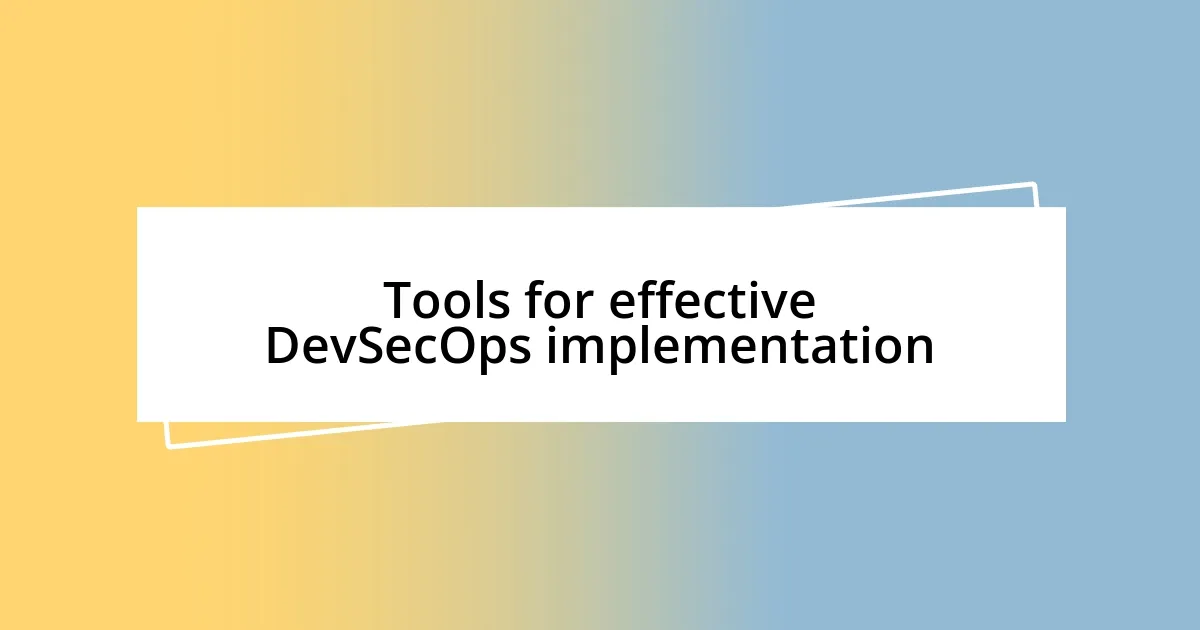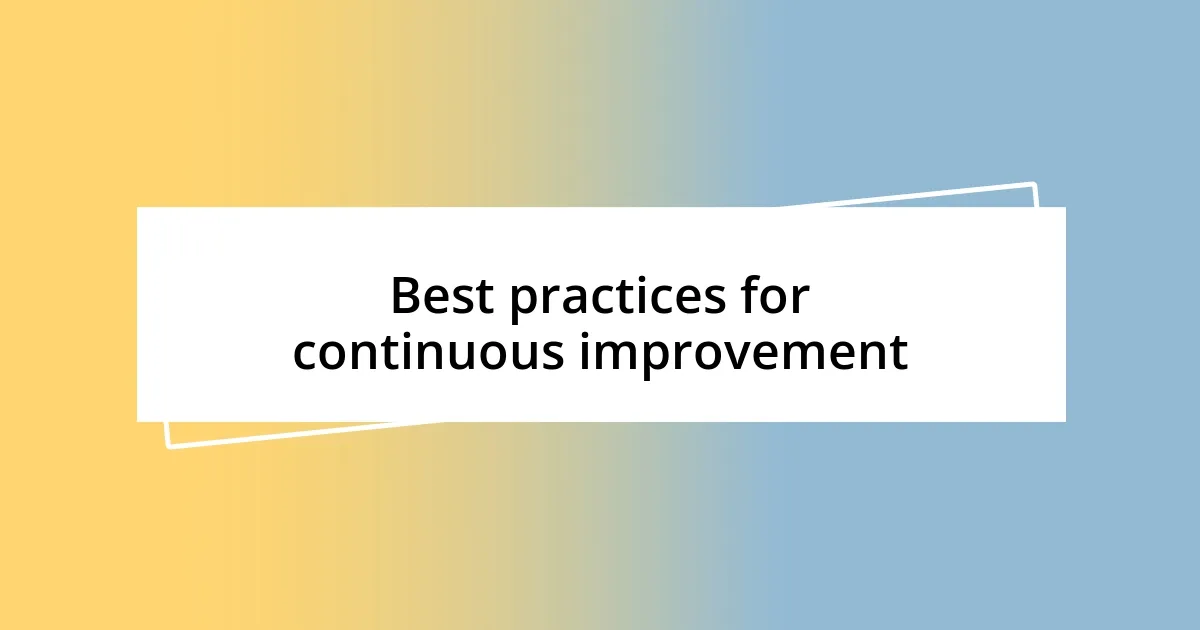Key takeaways:
- DevSecOps integrates security into the DevOps process by making it a shared responsibility among all team members, enhancing collaboration and breaking down silos.
- Key principles include shifting security left in the development life cycle, continuous monitoring, and automation of security testing, ensuring ongoing vigilance against vulnerabilities.
- Success can be measured through reduced security vulnerabilities, speed of incident response, and team collaboration around security goals, reinforcing the importance of culture in DevSecOps.

Understanding DevSecOps concepts
DevSecOps is more than just a buzzword; it’s a cultural shift that integrates security directly into the DevOps process. I remember when I first encountered the concept—I felt both intrigued and overwhelmed. How do we embed security without slowing down development? The answer lies in making security everyone’s responsibility, rather than placing it solely in the hands of a dedicated team.
At its core, DevSecOps emphasizes collaboration across all teams, effectively breaking down silos that often hinder progress. This collaboration means developers, operations, and security professionals work side by side from the start. I’ve witnessed teams flourish when they embrace this mindset; it’s like flipping a switch where everyone becomes an advocate for security practices. Doesn’t that sound empowering?
Also, let’s not forget about automation. Implementing automated security testing tools during the CI/CD pipeline can significantly enhance the workflow. There was a time when I tried manually auditing every piece of code—what a daunting task! Now, with the right automation tools, we can catch vulnerabilities early, creating a safer product while keeping our momentum. Isn’t it thrilling to imagine a world where security has a seat at the table throughout the entire deployment process?

Benefits of DevSecOps integration
The benefits of integrating DevSecOps into development practices are profound. For one, it significantly reduces vulnerabilities and security risks. I can recall working with a team that adopted these methods; the moment we integrated security checks into our daily routines, we saw a remarkable drop in the number of security incidents. Seeing our operations run smoother and with more confidence was a real game-changer.
Moreover, a culture of continuous feedback emerges. Teams that share responsibility for security often find themselves supporting one another more effectively. I remember exchanging insights with team members during our daily stand-ups, where we would discuss challenges and solutions related to security. This collaborative environment not only strengthened our security posture but also fostered a sense of camaraderie that made our work more enjoyable.
Lastly, integration leads to faster deliveries without compromising quality. With automated security measures embedded into the pipeline, I’ve witnessed teams deploy products rapidly while knowing that they’re secure. It’s a relief to see that we can maintain pace while ensuring safety. The satisfaction of shipping a high-quality, secure product truly makes all the effort worthwhile.
| Benefit | Description |
|---|---|
| Reduced Vulnerabilities | Integrating security checks early helps in identifying issues sooner, resulting in fewer incidents. |
| Collaborative Culture | Sharing security responsibilities fosters teamwork and enhances problem-solving. |
| Faster Deliveries | Automation in security testing streamlines processes, allowing for quicker deployments without quality loss. |

Key principles of DevSecOps
DevSecOps is underpinned by several key principles that guide its successful implementation. One foundational principle is the concept of shifting security left in the development process. This means integrating security practices early, ideally during the design phase. I remember implementing code reviews with a focus on security parameters; it was rewarding to see team members become more aware of potential vulnerabilities even before the coding began. Shifting left truly not only mitigates risks early but also instills a proactive security mindset within the entire team.
Another principle is the emphasis on continuous monitoring and feedback. This approach transforms static testing into a dynamic process, where security is not a one-off consideration but rather an ongoing effort. I recall a project where we began holding weekly security check-ins. Each meeting became an opportunity to refine our strategies and address concerns head-on. This evolution created a shared responsibility and a culture where security was intertwined with our daily workflows, making it a natural part of our ethos.
Here are some key principles to keep in mind:
- Shift Left Security: Integrate security practices early in the development life cycle to catch vulnerabilities sooner.
- Continuous Monitoring: Keep assessing security throughout the development process, allowing for quick reactions to emerging threats.
- Collaboration and Shared Responsibility: Foster teamwork between developers, operations, and security experts to create a holistic approach to security.
- Automation: Utilize automated tools for security testing, making it an integral part of the continuous integration/continuous deployment (CI/CD) pipeline.
- Education and Training: Regularly train teams on the latest security practices and threats to enhance knowledge and awareness across all disciplines.
Embracing these principles empowers not just the individuals involved but also the product itself, creating a robust security foundation that can adapt to changing landscapes.

Tools for effective DevSecOps implementation
Choosing the right tools for effective DevSecOps implementation can truly transform how teams approach security. I’ve had the pleasure of using tools like Snyk and Aqua Security in past projects. These tools not only automate vulnerability scanning but also seamlessly integrate into our CI/CD pipelines. It felt incredibly empowering knowing that we could catch issues before they made it to production.
Another essential category is cloud security tools. For example, tools such as AWS Inspector provided invaluable insights during my time managing cloud environments. Seeing real-time reports on potential security issues gave us confidence and allowed for immediate action. Have you ever received a security alert just in time to avoid a deeper problem? Those moments remind me of the importance of staying vigilant and having the right tools at our fingertips.
It’s also crucial to consider collaboration tools that enhance security awareness among team members. Platforms like Jira not only help track tasks but also incorporate remediation efforts for identified vulnerabilities. I recall a time when a quick update on Jira led to a significant reduction in our security backlogs. It made me realize that combining tools effectively can streamline processes, allowing us to focus on what truly matters—delivering safe and high-quality products.

Measuring success in DevSecOps
One of the most effective ways to measure success in DevSecOps is by tracking the frequency and severity of security vulnerabilities identified in production. I recall a project where, after implementing a robust DevSecOps strategy, we witnessed a 40% reduction in vulnerabilities during our post-launch audits. Seeing those numbers drop not only boosted our confidence but also reinforced the team’s belief in the importance of early security integration. Have you ever felt that surge of accomplishment when hard work pays off in measurable results? It’s truly satisfying.
Another vital metric is the speed of incident response—how quickly your team can react to and mitigate security threats. During one intense week, our security team faced a potential breach. Thanks to our refined processes, we had a resolution in place within hours. That experience taught me how critical it is to prepare for the unexpected and how successful implementation of DevSecOps can enhance our ability to safeguard our assets efficiently.
Additionally, team collaboration plays a significant role in measuring success. Tracking how often developers, security, and operations teams engage with each other over shared security goals can provide insight into the overall health of your DevSecOps culture. I remember when my team adopted daily scrums to discuss security-focused tasks; the transparency fostered not only improved our collective knowledge but also cultivated trust among team members. It’s fascinating how communication can be the real linchpin in our success. What have your experiences been in team dynamics affecting security outcomes?

Best practices for continuous improvement
To ensure continuous improvement in DevSecOps, establishing a feedback loop is essential. I remember implementing regular retrospectives after major releases, where the team would openly discuss what went well and what didn’t regarding security. This practice not only helped us identify areas for enhancement but also fostered a culture of openness and learning within the team. Have you found that reflecting on past experiences aids in forming better strategies?
Another best practice is to embrace automation without losing the human touch. For instance, while automating vulnerability scans significantly reduced the workload, I realized that periodic manual reviews were still crucial. It was during one of these reviews that we discovered a subtle but critical misconfiguration that could have led to significant security risks. The balance between automation and human oversight has proven to be a powerful driver of continuous improvement.
Finally, investing in training and knowledge-sharing sessions is a game-changer. I recall setting up monthly workshops where team members shared insights on the latest security trends and tools. These sessions sparked vibrant discussions, and we often left with fresh perspectives that inspired innovative solutions to ongoing challenges. How often do you invest in your team’s growth to ensure they’re not just keeping up but leading the charge?














